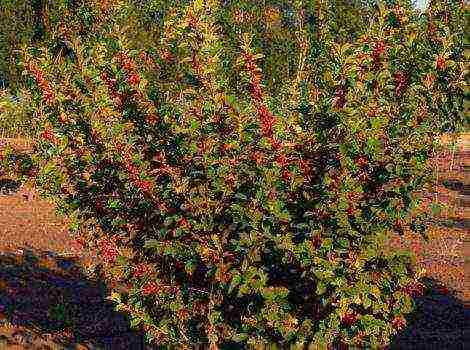Content
About a thousand grape varieties are grown in the Far East. Both European and American varieties grow here. But the leaders among them are those bred by our breeders on the lands of Primorye and Priamurye.
To a large extent, this happened thanks to the efforts of enthusiasts - true fans of the vine, who not only selected varieties for their zone, but also developed specific methods of growing them. One of them, Dmitry Lebedev, lives in the village of Lermontovka, Bikinsky District.
Experienced winegrower Dmitry Lebedev
Dmitry is a graduate of the Agricultural Institute, a relative of Lyubov Lebedeva, the author of the book "Grapes in the Far East" (there is still no better textbook on this topic), which describes in detail the agricultural technology of cultivation. He moved to Bikinsky district several years ago from Khabarovsk. It was here that he began to realize his dream - he laid a marketable vineyard.
- You shouldn't be afraid to grow grapes, - Dmitry is sure. - This is a very grateful crop and responds to good care with a rich harvest. I think every gardener has tried to grow this sunny berry at least once. Someone failed, and he waved his hand. And someone went further, by trial and error, choosing their own growing option, taking into account the conditions inherent only in his garden plot. And here not only these or those methods are important, but also the grape variety. As they say, everyone chooses for himself.
I can't even say how many varieties are in my vineyard now. Some varieties are already grown on an industrial scale. That is, we collect berries from them, multiply them. There are those that are just being tested. Something, perhaps, will be removed altogether.
Now there are many publications on which you can independently learn to plant grapes, you can buy ready-made.
“The best variety” is different for each grower. For one, it is important that the vines winter easily, without requiring much work to shelter from frost. Others prioritize taste. Still others insist that the grapes produce seedless berries. Unfortunately, it does not happen that one variety has all the desirable qualities at once.
When choosing a variety, I would advise you to pay attention to the excellent varieties of our seaside selection. They are rooted and grow quietly in the Khabarovsk Territory and, most importantly, most of them are resistant to diseases, almost not affected by mildew.
Varieties from the selection of Adelia Vaskovsky
A well-known breeder of Primorye, he bred more than 40 varieties.
Express - the variety grows on its roots, our summer is enough for the harvest to ripen. Spherical raceme, some berries without seeds. It is a very strong, powerful variety, fruitful and high in sugar. It makes an amazing juice that everyone can drink - it does not irritate the stomach. Sometimes it is affected by mildew.
Souvenir variety Vaskovsky
Adele - the variety grows on its own roots, our summer is enough for the harvest to ripen. The shape of the bunch is classic, all berries are with seeds. This variety was bred as a wine variety. Sometimes it is affected by mildew.
Vaskovsky's uncovering pink is the only uncovering table variety. Very resistant to mildew. Harvested. The taste is excellent. One of the best varieties in terms of the sum of qualities.
Varieties from the selection of Dmitry Novikov
A winegrower from Ussuriysk, whose labors have developed the best Far Eastern varieties
Olesya Dalnevostochnaya is a universal variety. Suitable for both fresh consumption and processing. The berry is thin-skinned, melting in the mouth, with a very sweet pulp. This grape is no different from the European varieties that are brought to us from Central Asia. It makes an amazing wine - thick and yellow, with a rich aroma of dried apricots and raisins. This variety spits in early September.
Olesya Dalnevostochnaya is a variety for centuries. And how much his people will plant, so much will thank the breeder.
Variety Olesya Far East
The grape cob is one of the last varieties bred by D. Novikov. The berries are green, the taste of a green sweet apple. A very elegant bush, the brushes are arranged as if upright. This is the grape variety from which real champagne is made. Unclear, with a fountain in the ceiling - everything is in the best traditions of France.
Other varieties of Far Eastern breeders,
which are worth paying attention to
Taiga emerald (breeder Nikolai Tikhonov, candidate of agricultural sciences, student of Ivan Michurin, bred more than 20 varieties of grapes) is one of the most famous seaside varieties. Released in 1958.
The brush is small with large green berries with a thick peel. Pleases with a constant harvest every year in any weather. Even if the whole summer is rainy, and the sun came out only for a week, he will still take his own, pick up sugar. Other grapes will remain watery in a damp summer, while taiga emeralds will always have a rich taste.
Resistant to all diseases.
Variety Taiga emerald
Russian Concord (bred by Ivan Michurin on the basis of Amur grapes) - this variety has long been tested in the Khabarovsk Territory. It is late, ripens on October 5th. And this is wonderful: there is already nothing, but he is still singing! And it keeps well. Can be stored in potato storage at + 4 degrees.
Khasansky Bousa (bred by A. Bous, a researcher at the All-Union Research Institute of Winemaking and Viticulture "Magarach", based on wild Amur grapes) is one of the best varieties of Far Eastern grapes. This is a non-covering variety. It is only necessary to cover it for the first three years. Then you can form a high stamp and just lay it under the snow for the winter.
Unlike other varieties, which usually have 30-40 fruiting shoots, Khasansky Bous has about 100 of them! The bunches of this variety are small, cylindrical. The berries are small, round, black. The pulp is fleshy and juicy, sweet and sour with a weak isabelle aftertaste. Used fresh and for juicing.
One Polish winegrower has been growing European varieties for many years, but it didn't work out very well. The Russian guests advised him to Khasansky Bousa. The farmer has been growing it for 15 years and gets everything: fresh berries, juice and wine.
This variety is appreciated as a frost-resistant form for landscaping gazebos and verandas.
Advice from the wine grower Dmitry Lebedev
1. Don't rush to open the grapes.
For some reason, everyone thinks that the grapes will rot under cover. But few people take into account that the Far East has a very long spring period. Low-plus temperatures remain until the end of April. Just at this moment, the brushes in the kidneys grow and complete. At this time, there are often return frosts, and the temperature is -3 gr. destructive for the brush.
Under the shelter, there is a constant positive temperature, under which the grapes gradually thaw. On the street + 25, and there, due to the fact that the earth is gradually thawing - + 4 + 8. This is a very favorable temperature for additional kidney formation.
Therefore, it is better to open the grapes later, on May 9-10. The grapes will wake up, the brushes will turn out to be an order of magnitude larger, which means there will be more harvest.
2. Rows of grapes are best located from east to west, this is a feature of our area. At the same time, the sun illuminates the brushes as much as possible, the berry picks up more sugar.
In Primorye, the brushes are covered with leaves so that they do not burn out.
3. A gardener who decides to deal with grape seedlings must have at least 200 mother bushes of the same variety. And for grafting, choose only the best bushes.
Grape sort Far Eastern Novikov - a universal purpose and an ultra-early ripening period, the berry ripens in our rather northern Tver and adjacent regions on August 20-30, depending on the season, In central Russia and more southern ones, in the first decade of August.
The originator is Dmitry Maksimovich Novikov. A few words about this breeder - D.M. Novikov worked in the structure of the Ministry of Agriculture and created about 30 varieties of grapes. The task that he set for himself and decided was to develop comprehensively stable and fruitful grape varieties that are not inferior in quality to European varieties and are suitable for cultivation in the Primorsky Territory.
And not only! Photo-variety Far Eastern Novikov in the north of the Tver region. Leaves
large carved,
The bush is vigorous. The flower in the descriptions is indicated as bisexual, but there is a version that it is female. But the berries set very well. Far Eastern Novikova blooms in early June, simultaneously with Zilga, two weeks later than Valiant, Khasansky Sladky and Express, and then sharply accelerates its growing season and ripens from all of these first - 10-15 days earlier.
The coloring of DVN berries begins in July. The bunch reaches 250-270 grams,
The berry is almost black, round, very juicy, up to 4 g in size, there is no mucous sac. When ripe, the grapes acquire a harmonious, very original taste with intonation of chokeberry and blueberry (in other seasons it can be weak nutmeg). Sugar content 21-22 brix.
Far Eastern Novikov is resistant to frost up to - 29 gr. , in our conditions, it is absolutely resistant to mildew and rot, i.e. it is practically a complex resistant grape. Grown in a covering culture with a standard air-dry shelter. Productivity, when irrigated, is very high, without watering, average ..
Far Eastern Novikov grapes are suitable not only for food, but also for making juice and wine. Which one?
We tasted the wine from the Novikov Far East grape variety back in 2012 - semi-dry, very harmonious taste - with a colleague from Moscow region, Mikhail, in 2014, another colleague had a dessert monovino with a very good taste. Then we did the wineries ourselves, tried to do both mono and in the same place with other Amur people, for example, the Vaskovsky Express.
And we got a successful wine, light, without bitterness and excessive astringency - dry and semi-dry. An interesting bouquet - chokeberry, blueberries and other berries, plum, hazelnut.
In this unfavorable 2017, the Novikov Far East grape variety is one of the few varieties that successfully endured both winter and frost, did not get sick in the summer and gives some hope for the harvest ... The vine has already begun to ripen ..
A very promising variety for northerners and northwest!
Advice to beginners - the sweet grapes of the Far Eastern Novikov are very fond of not only people, but also wasps. We must protect the grapes from them.
Table of contents:
- Introduction
- Structure of grapes
- Cultivated grape species, their significance and biological characteristics
- Grape varieties
- Biological features of the growth and development of grapes in the Far East
- Growth and ripening of shoots
- Winter hardiness
- Fruitfulness and productivity
- Economic and technological evaluation of varieties
- Growing planting material
- Growing grafted seedlings
- Vineyard
- Forming and pruning a vine bush
- The device of supports and the garter of grapes
- Vineyard renovation
- Vineyard fertilization and soil care
- Protection of vines in winter
- Diseases and pests of the vine
- Collection, storage and processing of grapes
- Calendar of main works in the vineyard and in the school
- Literature
Grape varieties
Suitable for cultivation in the Far East are varieties that have a short growing season (110-135 days), good ripening of the vine and full ripening of berries with a total of 2200-2500 ° C, high resistance to fungal diseases. These qualities provide frost resistance to winter hardiness of grapes and largely determine the marketable, taste and size of the harvest.
As a result of many years of research on selection, varietal study and generalization of the experience of noble amateur winegrowers, a grape assortment was selected in accordance with these requirements. At present, more than 20 varieties of grapes can be recommended for amateur and about 15 for industrial viticulture. Some of them are distinguished by increased frost resistance of the root system and are recommended in self-rooted culture in all regions of Primorsky, in the southern regions of the Khabarovsk Territories, in the Amur Region. The group of own-rooted varieties includes: Alpha, Taiga emerald, Khasansky Bousa, Far Eastern Ramminga, Primorsky. The other, most of the varieties are characterized by a significantly lower frost resistance of the root system and needs to be grafted onto a frost-resistant stock.
For industrial vineyards in grafted culture, the following varieties are recommended: Shasla Ramminga, Early Magaracha, Wilder, Early Violet, Don Muscat, Russian Concord, Latvian Pink, Extra; for home vineyards, in addition, varieties Pearl Saba, Madeleine Angevin, Seedling Malengra, Gold of Don, Ornamental, Hungarian Muscat, Seed Ferronova, Pugovichny, Shasla white, Shasla rosea, Agavam, Lydia.
In the most recent years, the varieties Aleshenkin, Rizamat, Lel, and Cardinal have been very popular among amateur winegrowers. Variety Alpha, seedlings of Amur grapes and its hybrids - Buitur, Far East Tikhonova, Korinka Michurina, etc. are used as frost-resistant rootstocks.
Among the recommended varieties, a group with a functionally female type of flower should be highlighted - Madeleine Angevin, Seyanets Malengra, Wilder, Russian Concord.
Amur grapes and its hybrids also have a female type of flower: Far Eastern Tikhonova, Lapchaty (Suputinsky 60), Suputinsky early, which are of interest for testing in the more northern regions of the Khabarovsk Territory, in the southern regions of the Sakhalin Region.
EARLY VARIETIES
Shasla Ramminga. Bred by A. A. Ramming on the Primorsky fruit and berry experimental field. It is a complex hybrid between Amur grapes, European varieties and the North American V. Labrusca species.
Chasselas Ramming variety
In the Primorsky Territory, it is found everywhere both in industrial plantings and in personal plots. It is grown in Khabarovsk, Blagoveshchensk.
The young shoot has dense white pubescence. Annual ripe vines are dark brown in color. The leaf is medium, slightly three-lobed, dark green above, shiny, slightly bubbly; underneath with strong yellowish-green tomentose pubescence; veins are bare. The lateral notches are either slightly outlined or very small. The petiole notch is open, shallow, lancet, with a sharp bottom. The petiole and node are stained with anthocyanin, pubescent.
The flower is bisexual. The bunch is small, branched, loose. The stem of the bunch is grassy, dark pink in color. The berries are uneven in size, from small (12X14 mm) to medium (17X17 mm), round, light green with yellowness, covered with a thin waxy coating. The skin is thin, translucent, but firm, easily separated from the pulp. The pulp is juicy, with a slight aftertaste typical of American varieties; and a delicate nutmeg aroma that separates well from the seeds.
A variety of medium early ripening. The berries are fully ripe in the second decade of September. With the length of the growing season of 114-125 days, it requires the sum of active temperatures from 1900 to 2250 °. Growth is moderate on its own roots and strong in a grafted culture. On its own roots, the yield is low (0.7-2 kg / bush), depending on the overwintering of the roots.In a grafted crop, the average yield is 58-80 c / ha, on personal plots - up to 4-8 kg / bush (85-135 c / ha).
Ripening of shoots is good. Poorly tolerates overload, bears fruit, as a rule, better with a moderate pruning length (8-10 eyes) of fruit vines. Differs in high resistance to diseases.
Recommended in grafted culture in all viticulture zones of the Far East, in the Amur region.
Far Eastern Ramming. Bred in the Primorsky fruit and berry experimental field by crossing the Far Eastern Tikhonova variety with the Taezhny Emerald variety.
Since 1948 it has been included in the assortment of the Primorsky Territory. Here it is found everywhere in small quantities, as an admixture to the Alpha variety. It is also grown by amateur gardeners in other areas of northern viticulture.
Young shoot is light green, with slight cobweb pubescence. Annual mature vines are thin, straight, intense gray-brown color. The leaf is small, slightly dissected, almost rounded. The upper side of the leaf blade is slightly wavy, green; the lower one is light green with bristles along the veins. The upper notches are small, in the form of a reentrant corner; petiole notch open, lancet, shallow.
The flower is bisexual, very small, prone to shedding. The bunch is small, cylindrical, cylindrical, dense and of medium density. The mass of the bunch is 30-40 g. The berry is small (12X12 mm), round, black with a strong blue bloom. The skin is thin, strong, and separates well from the pulp. The pulp is gelatinous, juicy, light green, with pinkish veins under the skin, wine-sweet, pleasant taste. The juice is dark red. Belongs to the group of table-wine varieties of early ripening. The berries are fully ripe at the beginning of September.
With a vegetative period of 110–120 days, it requires 1900–2000 ° C active temperatures for full ripening.
The growth of the bush is moderate, the ripening of the shoots depends on the load and the degree of mildew damage. Average yield, 1.6-3 kg per bush, reacts strongly to overload. The optimal load is 22-26 shoots per bush. Fruit vines are cut into 8-10 eyes. Affected by mildew, anthracnose and gray rot.
Recommended as an additional variety for the preparation of vine, fresh consumption, and especially in the northern zone of viticulture (Khabarovsk Territory, Amur Region).
Don Muscat. Breeding VNIIViV them. Ya.I. Potapenko (SevernyX White Muscat). In the Primorsky Territory, it is distributed in personal plots and collection plantings.
The leaf is of medium size, ovoid, deeply dissected, three-lobed. The petiole notch is closed, with an elliptical lumen and a sharp bottom, sometimes open, slit-like. On the lower surface of the leaf there is a sparse bristly pubescence. The flower is bisexual. The bunch is large (average weight 150-170 g), dense, cylindrical-conical. Fruitfulness of shoots is moderate: fruitful shoots - 38–52%, bunches per fruitful shoot - 1.4–1.6. The berry is small and medium, round, black, with a pleasant nutmeg aroma, the pulp is juicy and crispy. The skin is thick, dense, and separates well from the pulp. The sugar content of the juice is 17-19%, the acidity is moderate —11 —13 g / l (at home it accumulates up to 30% sugar with an acidity of 6.7 g / l).
Shoot growth is strong, ripening is satisfactory. According to VT Boginich, in Vladivostok it winters well on its own roots, the average yield per bush is 3.9-4.4 kg, or 70 centners / ha. The growing season is 115-120 days, ripens in the south of Primorsky Krai in the first - beginning of the second decade of September. Resistance to the main diseases - mildew and fruit rot - is average.
Recommended for all regions of Primorsky, southern regions of the Khabarovsk Territory, in the Amur Region on a frost-resistant rootstock as a universal, high-quality, fruitful variety.
Early Magaracha (Magarach No. 372). Variety selection VNIIViV "Magarach" (Yalta). On the rootstock of the Alpha variety, it is successfully grown by gardeners in many areas of the Primorsky Territory, in Khabarovsk. According to G. T.Kazmina, gardener S. L. Zhukovsky near Khabarovsk for 10 years, growing the variety on the roots of Alpha, gets very high yields, up to 35-40 kg per bush.
The leaf is large, deeply dissected, five-lobed, elongated. The lateral notches and petiole are deep, closed, with an elliptical lumen. The underside of the plate is smooth. The flower is bisexual. The bunch is large and very large, up to 1.2 kg, medium density, conical and often winged. The berry is large, rounded black. The pulp is juicy, crunchy, with chocolate tones on the palate.
The growth of the bushes is strong, the vine ripens well and annually. The vine is thick, light brown with large eyes. In the Spassky region, the harvest ripens on September 10-15, in Khabarovsk the berries are fully ripe even in 1983, which was unfavorable for grapes. According to I.S.Vysoky, under any summer conditions, the berry does not crack, is not affected by gray rot. The cultivar is relatively resistant to mildew. The yield per bush is 8-10 kg.
Variety Early Magaracha on the site of I.S.Vysoky, 1963. Yield per bush - 9.55 kg (according to Yu.G. Bozhko)
In the Far East, it deserves much attention as an early, fruitful variety of excellent taste and marketability. Differs in good transportability and wide ecological plasticity. In grafted culture, it is recommended wherever grapes are grown.
Early purple. Bred in the All-Russian Research Institute of Winemaking and Viticulture named after Ya. I. Potapenko from crossing of North varieties with Hamburg Muscat, that is, it is a complex interspecific hybrid of Amur, American and European grapes. Approved in the standard assortment of many regions of the RSFSR as a universal variety with high table grape qualities and excellent dessert wines with a delicate rose aroma and good color. In the Primorsky Territory, it is distributed in collection plots, in amateur gardens.
The quality of the grapes in Primorye is high: the sugar content of the juice is 17-18%, the acidity is 12.2 g / l, keeping quality and transportability meet the requirements of table grapes.
The leaf is medium, rounded or slightly elongated, three-five-lobed with the edges downward, grooved along the main vein. The upper surface of the leaf is dull green, dull, large-bubble; the bottom is light green. The upper lateral notches are medium, open, with a narrow aperture and a rounded bottom; the lower notches are small, open, sometimes absent. The petiole notch is open, lancet, narrow and deep.
The flower is bisexual. The cluster is medium in size (16X12 cm), from cylindrical to winged, dense. The berry is medium, round, dark purple, with a strong waxy bloom. The skin is thick, dense, and separates well from the pulp. The pulp is dense, crispy, fleshy. The taste is pleasant, harmonious, with a strong nutmeg aroma.
The growing season is about 125 days. Ripens at the beginning of the third decade of September. Ripening of shoots is satisfactory, less often good. Growth is medium and strong. Productivity 3.3-5.2 kg per bush. The mass of a bunch is 80 g. Fruitful shoots are 38-47%, the number of clusters per fruitful shoot is 1.4-1.6. Mildew and anthracnose are moderately affected.
Recommended for frost-resistant rootstock for all viticulture zones of the Far East.
Extra. American origin (Witns Labrusca). It is found in the USSR in a mixture with isable varieties in the northern regions of the Ukrainian SSR, in the Sochi region. In the Primorsky Territory, it is found in individual bushes in home vineyards and in the collections of experimental stations.
The leaf is large, rounded and cordate, three-lobed, slightly dissected. The upper surface of the leaf is shiny, reticulate-wrinkled. The petiole notch is almost completely closed or with a slit, sometimes vaulted, narrow. The underside of the leaf has a strong cobweb pubescence.
The flower is bisexual. The cluster is medium, conical or cylindrical with a wing, loose. The berry is medium, round, less often oval, light pink.The skin is firm, thick, covered with a waxy bloom. The pulp is slimy. Uncolored juice. The taste is sweet and sour, pleasant, slightly astringent, with a strawberry aroma.
The growth of the bushes is strong. Ripening of shoots is good. The yield per bush is 1.4-5.4 kg. The mass of the bunch is 83 g. The sugar content of the wort when harvested is 13.9-16.8%, the titratable acidity is 9-13 g / l. Used for fresh consumption. Differs in a beautiful appearance of bunches and berries. Cultivated in conjunction with Russian Concorde, for which it is a pollinator. Suitable for decorative purposes.
In the Primorsky Territory, during the study of the Extra variety on the rootstock of the Alpha variety, the yield significantly exceeds the Violet Early and Shasla Ramminga varieties. Average yield, according to L. T. Slesarenko, 73 c / ha. In the southern part of Primorye, it winters on its own roots, accumulates up to 17-19% of sugar. Mildew resistance is significantly higher than that of European varieties and European-Amur hybrids.
Khasansky Bousa. Bred by the breeder A.K.Bous by pollination of the Far Eastern Tikhonov variety with the pollen of Amur bisexual grapes.
The crown is purple. One-year mature shoot is thin, dark brown with a reddish tint. The leaf is large, three-lobed, slightly dissected, resembles a leaf of the Alpha variety. The surface of the leaf blade is smooth, even, without pubescence. The upper side is green, the lower is pale green. The lateral notches are small, open, in the form of a reentrant angle. Sometimes lower lateral notches are also visible. A petiolate notch with a bottom bounded by veins.
The flower is bisexual. The cluster is medium in size (15-24 cm) and small, dense, the shape varies from cylindrical to winged. The berry is small, round, black. The skin is thin, delicate. The pulp is juicy, melting, the juice is weakly colored.
Polishing is either not observed, or is very rare. The taste is sweet-sour, pleasant, without aftertaste and aroma. It belongs to the group of wine varieties with a medium early ripening period. The full ripeness of the berries occurs in late August, 15-20 days earlier than that of the Alpha variety. The growing season (from the beginning of blooming to full maturity) is 110-125 days. For full ripening of berries, the sum of active temperatures of 2100-2200 ° is required.
The variety is vigorous, the cuttings are poorly rooted. High frost resistance. According to Bousa, it hibernates openly in the Khasan region. They do not shelter him in numerous household plots, both in the coastal and in the continental zones of the region.
Differs in high rates of fruitfulness, which makes it possible to get up to 10-12 kg of grapes from a bush. Against the background of high agricultural technology, the variety can have a yield of 100-150 centners / ha (Boes, 1963).
The author of the variety recommends pruning fruit vines by 8-10 eyes at a load of 80-100 eyes per bush.
Mildew resistance is not high enough. In terms of the complex of economic and biological properties, it is close to the Amur grapes, which is explained by the dominance of the heredity of the Amur grapes. However, the taste of the berries is much higher than that of the Amur grapes and of the Alpha variety. The tasting score of the Khasansky Bousa variety is 8, and for the Alpha variety - 6 points (when judged by a ten-point system).
Berries can be stored on the bush for a long time. The variety can be used to prepare dry red and white table wines, as well as drinks.
The disadvantages of the variety include the small size of the berries and poor transportability. Recommended as a frost-resistant variety for cultivation in all areas of the Primorsky Territory without shelter for the winter. It is especially promising for areas with a short frost-free period and severe winters (Khabarovsk Territory).
Young bushes must be covered in the first two years after planting.
It is generally accepted to consider grapes as a plant that grows exclusively in southern countries. This opinion is erroneous and irrelevant today. Thanks to domestic and foreign breeders, the range of varieties is periodically replenished with new developments, adapted to different climatic conditions, information about which is presented below.
Growing grapes in different regions of Russia
The territory of Russia is vast, so the climate in the regions can vary significantly. In many parts of the country, a crop such as grapes is successfully grown. In addition, the vine is unpretentious to the soil, the only exceptions are saline and wetlands. Before planting a seedling, the soil is fertilized with organic matter. It is enough to enrich the soil once a year. When choosing a place, it is worth considering that the life cycle of a plant is approximately 25-30 years, therefore, an indent of 1.5 m should be made from the walls of the fence and buildings. The best planting time is autumn, namely September. But the timing may vary depending on the climatic characteristics of the regions.
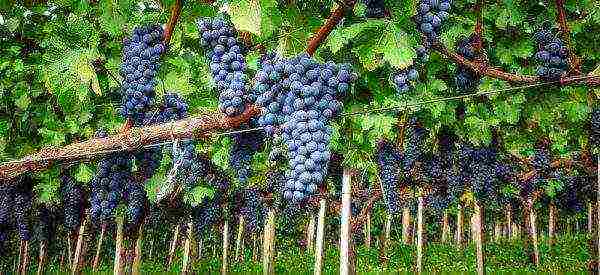 Many gardeners are engaged in viticulture, both in the south of Russia and in regions with harsh climatic conditions.
Many gardeners are engaged in viticulture, both in the south of Russia and in regions with harsh climatic conditions.
In order to consistently remove a good harvest from the vine, you need to choose varieties that are recommended for growing in certain conditions.
Krasnodar region
The climatic conditions of the Krasnodar Territory are considered ideal for grapes, therefore the best varieties are grown on this territory. The ratio of warm days per year, average rainfall and sunlight make a good foundation for stable fruiting in vineyards.
The main grape production is concentrated in the Anapo-Taman zone. The harvested crop is distributed to other industries for processing and markets for fresh consumption. Harvesting season begins from the third decade of July and lasts until mid-October.
In the Krasnodar Territory, grapes are grown both in an open way and using a shelter.
It is impossible to list all the varieties grown on the territory of the Krasnodar Territory, since the vineyards are constantly replenished with new developments of breeders. The following types of culture are considered the most popular:
Madeleine Angevin
 Madeleine Angevin grape
Madeleine Angevin grape
A vigorous plant with an early ripening period. Harvesting begins in mid-August. Productivity depends on the quality of pollination, the best pollinator is Chasselas, so both crops are planted next to each other. The average weight of a bunch reaches 180-200 grams. The berries contain 15% sugar and 6.7% acid.
Pearl Saba
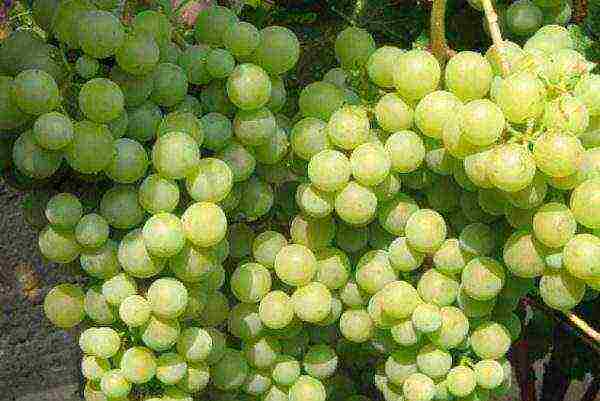 Early grape variety Pearl Saba
Early grape variety Pearl Saba
The berries ripen in late July - early August. The yield is high (over 8 kg per bush), stepchildren bear fruit abundantly. After planting the shanks, the plant bears fruit for 2-3 years. The ratio of sugar content (16%) and acidity (7.3%) is close to the ideal value. Possesses strong immunity, resists fungal diseases. Due to the shortage of planting material, reproduction by grafting is practiced.
Shasla white
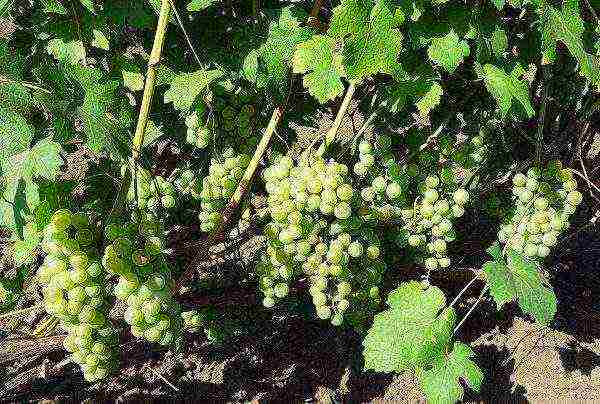 Chasselas white grape
Chasselas white grape
It is one of the main ones, which is massively grown in the Krasnodar Territory. The plant enters the fruiting phase early (already in the 2nd year), the bush is formed of medium size, the immunity is strong, which can be traced in resistance to fungal diseases. The berry is distinguished by its high taste (sugar 15%, acid 6.7%) and good transportability.
Chaush
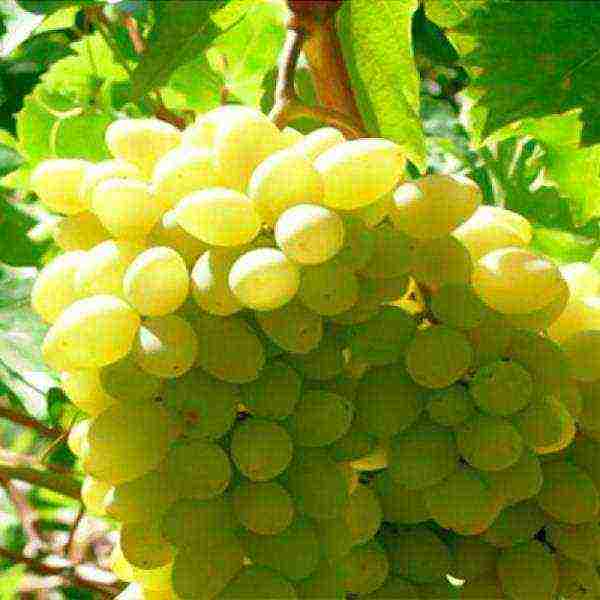 Chaush grape variety
Chaush grape variety
An early ripe variety, found throughout the region, but in small quantities. The harvest is ready for harvest in the third decade of August. On tall bushes, large clusters are abundantly formed, the weight of which reaches 420-500 grams. Productivity depends on the quality of pollination, the best pollinator is Chasselas, so both crops are planted in close proximity. Indicators of sugar content - 14%, acidity - 6%.
Hungarian Muscat
 Hungarian Muscat grape
Hungarian Muscat grape
The plant enters the fruiting phase in the 3rd year after planting of seedlings. Muscat bushes are medium-sized with actively developing vines.The honey flavor of the berries indicates a high sugar content (over 20%), with a relatively low acidity (6.5%). A bunch of medium size weighs up to 160-170 grams. It is intended for consumption of fresh berries and for processing into juices.
Senso
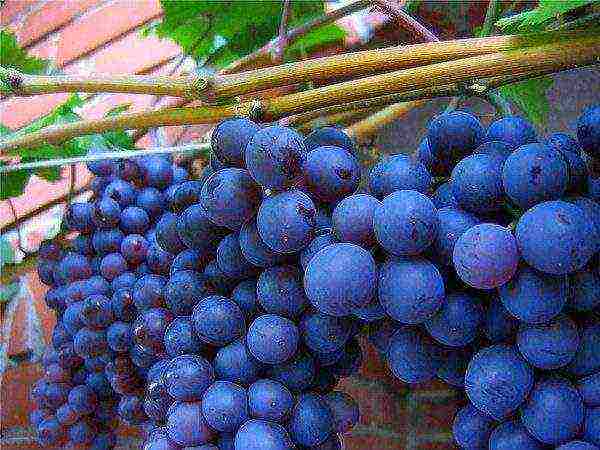 Senso grapes
Senso grapes
The plant is native to France, has a high yield. More than 7 kg of berries are removed from the bush. The grapes reach ripeness by the second half of September. The berries are large in size, dark blue in color with a characteristic waxy coating. The taste harmoniously combines sugar content (18.3%) and acidity (7%). The mass of a bunch of medium size is 232 grams.
Crimea
An equally varied menu of grape varieties grown on the peninsula. The total number of varieties is close to a hundred. Favorable climatic conditions and soil fertility contribute to high yields. The lack of precipitation is compensated by the arrangement of the vineyards with a drip irrigation system. When planting plants, use the scheme: 3x1.5 m. The largest plantations are located in the foothill zone (Bakhchisarai district), steppe (near Simferopol), as well as in the suburbs of Yalta, Alushta, Sudak.
Among the fruitful ones, the following stand out:
Agadai
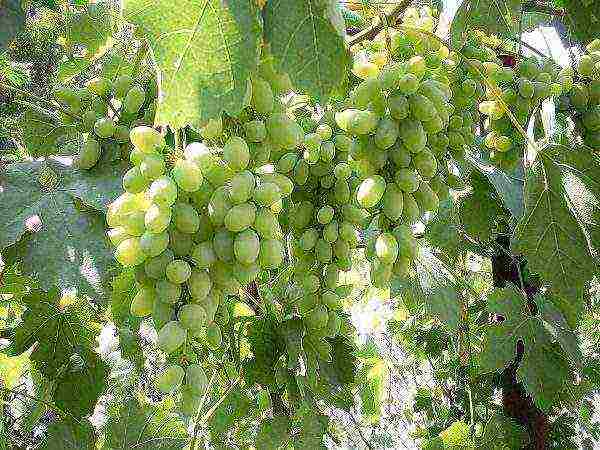 Agadai table grapes
Agadai table grapes
A table variety originally from Dagestan, it is distinguished by a late ripening period. Harvesting begins no earlier than the 20th of September. The plant develops normally on soils with a high salt content. In addition to fresh consumption, the crop is used for canning and making juices.
Albiglio Crimean
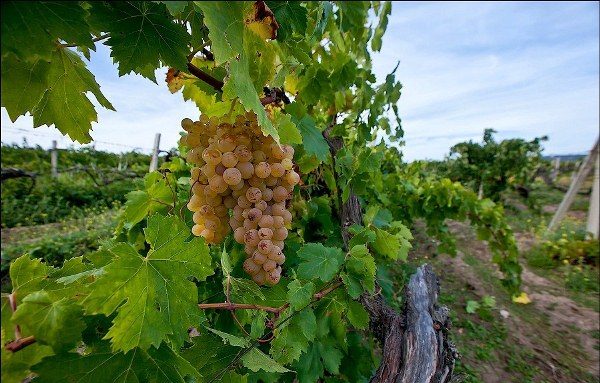 Crimean Albillo grape
Crimean Albillo grape
A medium-ripening plant native to Spain. Grown for winemaking. The yield is 7-9 kg per bush. The berry contains 14% sugar, 6.7% acid.
Italy
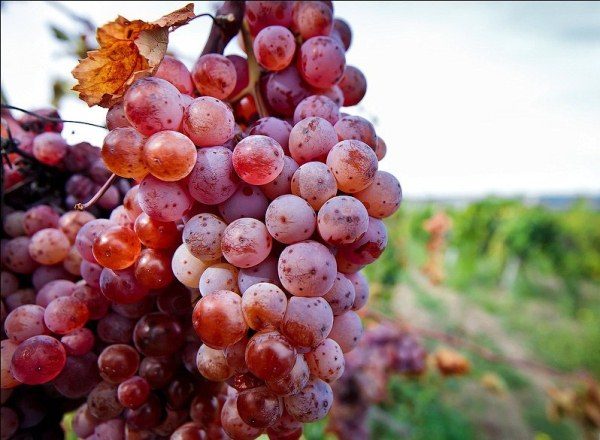 Grape variety Italy
Grape variety Italy
Large grapes, collected in loose bunches, the average weight of which reaches 450 grams. Yellow-amber berries have a pleasant taste with a pronounced nutmeg note.
Cardinal
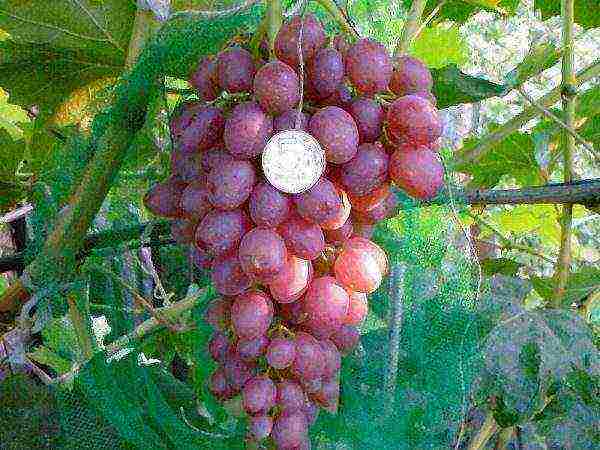 Cardinal grape
Cardinal grape
The berries ripen by the end of August. The bunch is formed loose with a lot of grapes, the average weight is 250-350 grams. The taste is not sugary, although the sugar content is at least 16-17%. Differs in resistance to fungal diseases and good transportability.
Citron Magaracha
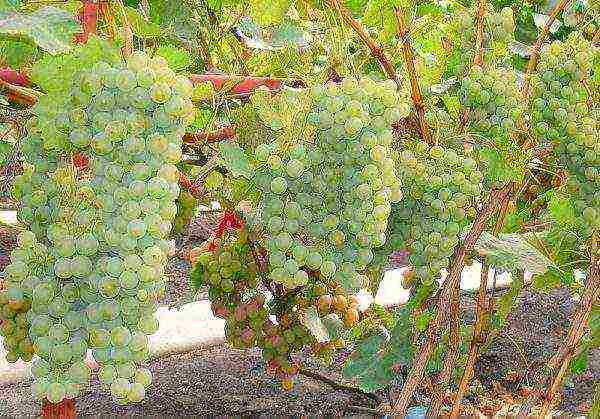 Grape variety Citron Magaracha
Grape variety Citron Magaracha
An early ripening wine variety. The quality of taste and presentation makes the berry edible and fresh. The weight of a cylindrical brush reaches 400 grams. Sugar content is high (23%) with an acidity of 5-7%.
Sabbat
 Sabbat grapes
Sabbat grapes
The culture is grown for fresh consumption and the production of wine material. White berries ripen in late September - early October. Large bunches are hung up to 280 gr. Even after storage in the refrigerator for 5 months, the grapes do not lose their taste and marketability.
Astrakhan region
Astrakhan region is a promising area for growing grapes. This is facilitated by the hot climate and the presence of the Baer hillocks. The deep bedding of groundwater leaves more chances for plants to endure winter frosts.
An important factor is the absence of insects that pose a danger to vineyards.
Over the entire period of the existence of viticulture on an industrial scale, more than 300 varieties have been tested on the Bair hills. The highest results were observed with the cultivation of the following varieties.
Codryanka (white)
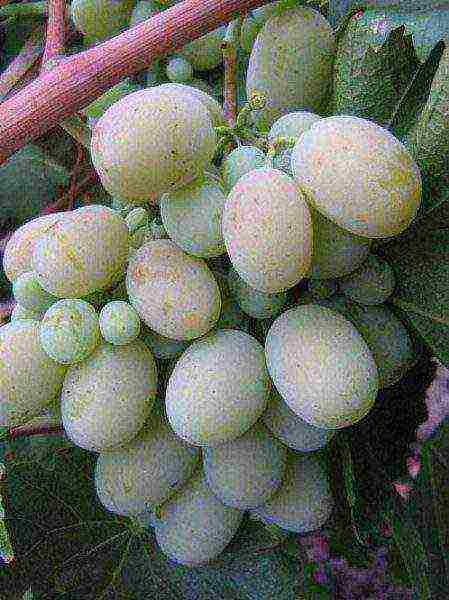 White Codryanka grape
White Codryanka grape
The plant is of a medium late ripening period with a growing season of 130-140 days. Berries of greenish-yellow color have a rounded-oval shape, the weight of one reaches 10-12 grams. The mass of a medium-sized brush is 600-800 gr., but there are also giants weighing 1.2 kg. The shrub can easily tolerate frost down to -23 °. Codryanka is resistant to mildew and gray rot.
Delight
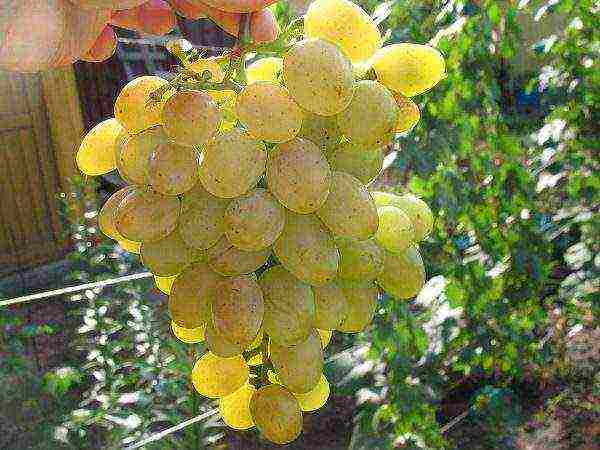 Bunch of grapes Delight
Bunch of grapes Delight
Early, with a vegetation period of 110-120 days.Differs in increased resistance to fungal diseases and mildew. Frost resistance (up to -25 °) allows you to endure severe winters under cover. The yield of Delight grapes is more than 9 kg per bush.
Radiant kishmish
 Radiant kishmish
Radiant kishmish
Pink grapes of medium early ripening period (vegetation period 115-125 days). Advantages: high taste, market value, long shelf life. The weight of a bunch of medium size reaches 250-450 grams. The sugar content is 17-21%, the acidity is 6-7%.
Moskovsky
 Moscow grape variety
Moscow grape variety
The plant is early ripening, has an unusual taste, filled with nutmeg and pineapple aromas. The culture is resistant to low temperatures, fungal diseases. The bunch is small, the weight does not exceed 150 grams.
Vologodskaya Oblast
The climatic conditions of this region cannot be called ideal, but even there it is possible to grow grapes. Industrialists use frost-resistant varieties. Additionally, they are covered with a special material for wintering. Private gardeners have gotten used to planting cuttings in greenhouses. Recommended for the middle band:
- Laura - large green grapes have a pleasant taste, the bushes easily endure winter;
- Shunya - large-sized dark pink fruits ripen by the end of August, the plant is resistant to disease;
- Nadezhda Aksayskaya - ripens at the end of August, in taste and externally, the berry is similar to the Arcadia variety;
- Victoria - beautiful large clusters with sweet berries, high yield (at least 7 kg per bush);
- Phenomenon - ripens in mid-August, medium-sized berries are very sweet in taste .;
- Gala - very large fruits, formed into a loose bunch, are being tested in the region;
- Cherry - early ripening plant, medium-sized pink fruit with high sugar content.
Primorsky Krai
The weather conditions of the region do not allow the cultivation of any grape varieties, therefore, special breeding ones with frost resistance are selected. Among other things for the winter period, the bushes are covered with a special material to prevent freezing.
Adele
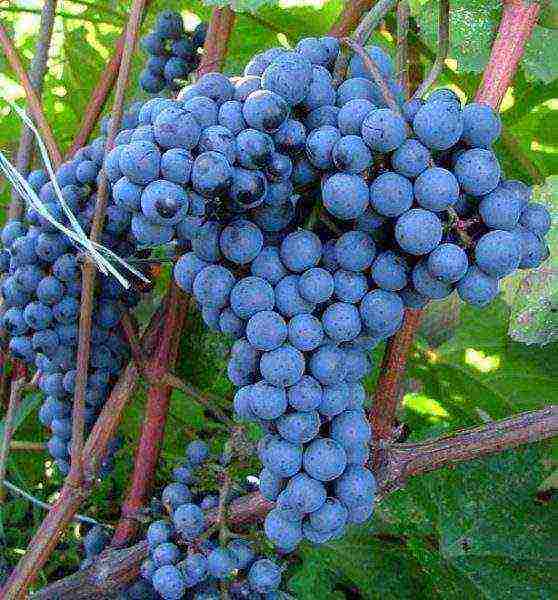 Adele grapes
Adele grapes
Designed for growing under cover. The mass of a medium-sized brush reaches 600 grams. Medium sized berries, dark blue color. The peculiarity of the variety is long-term storage, the grapes retain their presentation until the New Year holidays.
Far Eastern Novikov
 Grape variety Far Eastern Novikov
Grape variety Far Eastern Novikov
A universal variety of early ripening. Withstands frosts down to -28 °, but requires shelter for the winter period due to the climatic features of the Primorsky Territory. The bunch is small, weighing up to 250 gr., Dark blue berries with an unusual, but original taste.
Satellite
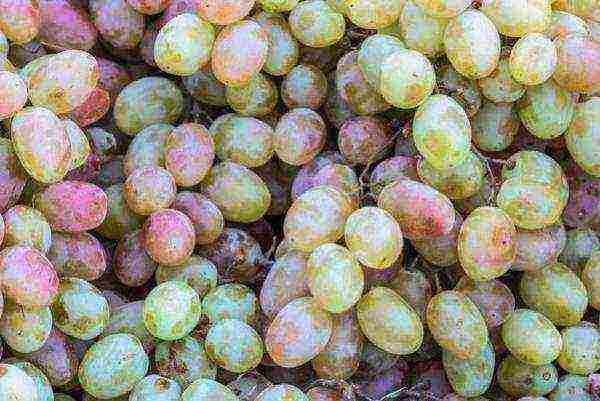 Grapes Satellite
Grapes Satellite
The plant is early maturing with greenish-yellow grapes, the weight of which does not exceed 8 grams. The advantage of the variety is frost resistance (-30 °), however, shelter is required for wintering. The fruits contain 16% sugar content and 7-9% acidity.
Pink is not a covering
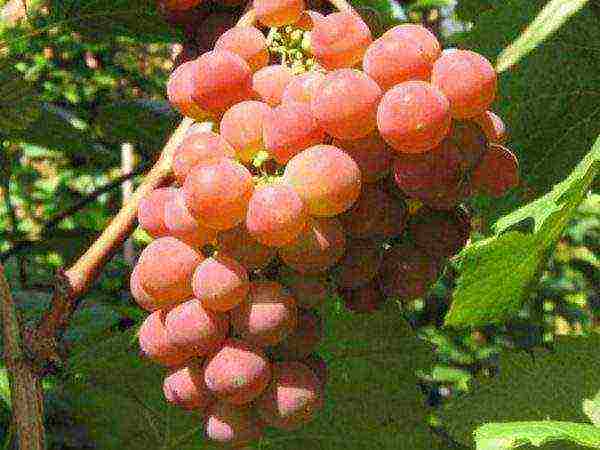 Grape variety Pink not covering
Grape variety Pink not covering
Early maturing table variety. The berries are very tasty (sugar 20%), but small. Bunch weight - 150-200 gr. The crop does not lose its presentation for a long period, even on the vine. Under proper conditions, it is stored until the New Year holidays.
Rostov region
The climate of the Rostov region is also suitable for growing the best varieties of grape selection. There is enough light, heat and moisture here. However, to select a type (covering and not covering), you should visually divide the area into 2 parts, above and below Kamensk. Non-covering varieties are recommended for planting in the south.
Not everyone is aware of the fact that wines are produced in the region, which are a real competitor to French collection drinks. Popular varieties include:
- Valentine;
- Autumn black;
- Mascot;
- Arcadia;
- Somerset Sidliss et al.
Every year, vineyard owners practice updating the assortment of varieties, using proven varieties of grapes and the latest developments. New approach and application of innovative technologies allows you to increase the profitability of agricultural enterprises, bringing their achievements to the world level.
